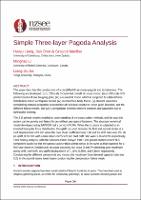Simple Three-layer Pagoda Analysis

Download
Date
2024-04-09Authors
Liang, Haoyu
Chen, Jian
MacRae, Gregory
Jia, Liang-Jiu
Li, Minghao
Metadata
Show full item recordAbstract
This paper describes the construction of a simplified three-storey pagoda and its behaviour. The following are developed: (i) a 1/20 scale 3-D printed overall structure model, (ii) a 1/10 scale 3-D printed model of one dougong joint, (iii) a numerical model which is subjected to a lateral force distribution and an earthquake record, (iv) element free-body forces, (v) element capacities considering material properties expected for old Chinese structures, wood grain direction, and the different failure modes, and (vi) a comparison between element demands and capacities.
The 3-D printed models enabled an understanding of the construction methods, without special fasteners, and the force carrying mechanisms. The structure numerical model developed using SAP2000 had a period of 0.49s. For an inverted triangular force distribution, uplift occurred between the first and second stories at a roof displacement of 6 mm when the base shear coefficient was 0.66 and the drift ratio was 1%. At an uplift of 10 mm the base shear coefficient and roof drift ratio were 1.26 and 2% respectively. Time history analysis, with a record scaled so that the spectral acceleration at that period is the same as that expected for a 500-year event in Christchurch structure assuming soil class D and 5% damping gave maximum storey drift, roof drift, and uplift displacement of 1.11%, 0.58%, and 6.8mm respectively. Considering the different components and modes, the maximum force demand capacity ratio was 0.21 in the second-storey lower beam considering the compression failure mode.
